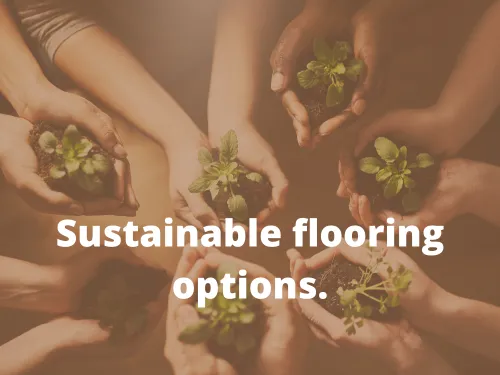Introduction
If you’re trying to make your home or office more sustainable, there’s probably no better place to start than the floor. After all, floors are where we spend most of our time—they’re a huge part of our offices and homes’ carbon footprint. While it’s easy enough to swap out old carpet for something new and eco-friendly (just as it is with furniture), it takes more work when you want to replace tile or wood flooring in an existing space. But that doesn’t mean you shouldn’t do it! Here are five great sustainable flooring options.
1. Linoleum floors
Linoleum is made from linseed oil (derived from flax), cork dust and jute. The most sustainable option for this flooring is the Red List Free and Climate Positive Flooring version, which means it’s a non Greenwashed linoleum floor. It’s 100% recyclable and made with renewable resources, so you can feel good about using linoleum as flooring material.
Although it doesn’t biodegrade on its own like bamboo does, it’s still considered “green” because of how quickly it decomposes in nature once thrown away in an eco-friendly compost pile—much faster than most other hardwood products out there! What makes this material so great for the environment is also what makes it desirable as a safe alternative to other materials like vinyl or laminate: unlike their counterparts, they don’t contain toxic chemicals such as formaldehyde or PVCs that release dangerous fumes over time when exposed to heat sources like fireplaces or ovens (which can cause respiratory illness). In our opinion is a linoleum floor the best option of the sustainable flooring options.
2. Cork flooring
Cork is another sustainable flooring option that has been around for centuries. Made from the bark of cork oak trees, it’s a natural product that can be recycled and revitalized when it reaches the end of its useful life. Cork floors are also highly insulating, making them great for homes with uneven temperatures or hot spots in the room (like near fireplaces). In addition to being durable and resilient, cork is often considered a good insulator because it holds warmth while keeping noise out.
3. Wool carpet
Wool carpet is an excellent choice for a flooring material that’s both sustainable and durable. Wool is a natural fibre and can be easily recycled, while its fibres are resistant to stains and moisture. Plus, it’s easy to clean: just sweep or vacuum as you normally would!
Wool carpets are ideal for any room in the house thanks to their durability, stain resistance and ability to insulate against cold floors. This makes them perfect for kitchens, living rooms or bedrooms where pets or children may be present.
Because wool carpet comes from animals like sheep or alpacas (who live on large farms), this product also has fewer environmental impacts than other materials such as plastic laminate flooring made from oil byproducts.
4. Bamboo
Bamboo is a sustainable, renewable resource that grows quickly and can be harvested every few years. Bamboo flooring is made from the fibers of the bamboo plant, so it’s durable and resistant to moisture. It’s also hypoallergenic and fire-resistant, which makes it an ideal choice for high traffic areas like kitchens and bathrooms.
Bamboo floors come in a wide range of styles—from traditional to modern—making them an attractive option for any home decor style.
5. Reclaimed wood flooring
Reclaimed wood flooring is a great way to bring the beauty of nature into your home. It’s also a sustainable option, as it is made from old, discarded wood that would otherwise be thrown away. If you want reclaimed wood flooring in your space, there are many options available to you. You can choose from different styles and colors to create a unique look, or you can go with a more traditional style if you prefer.
You should consider using reclaimed woods when designing your new home or remodeling an older one — they’re perfect for any space! There are a lot of providers of reclamed wood flooring which are using greenwashing. So do research into it if you choose this as your sustainable flooring options.
Make sure to do your homework, and if you want to learn more about sustainable flooring options!
- Linoleum is a material made from linseed oil and resins, which are mixed with cork powder. Look also into lioquid Linoleum.
- Cork comes from the bark of a tree, so it can be harvested every 10-20 years without harming the tree. Cork has been used for hundreds of years, but it has recently become popular because it’s durable and plays well with other materials like vinyl.
- Wool carpet is woven using 100% wool fibers that are typically dyed to create different colors—some manufacturers use natural dyes for even more sustainable results! As an alternative to traditional synthetic carpets that contain harmful chemicals and heavy metals, wool can be recycled over and over again without losing its quality or comfort level (so no need to worry about pet stains!).
- Bamboo flooring offers many benefits: bamboo grows quickly without pesticides; it has natural antibacterial properties; it contains antimicrobial agents effective against bacteria such as E Coli 0157:H7; it absorbs carbon dioxide (CO2), providing additional benefits for indoor air quality; bamboo releases 35% less CO2 into the atmosphere than trees do when they’re cut down. Plus, bamboo flooring looks great!
Conclusion
As you can see, there are a lot of options out there when it comes to choosing the best material for your floor. We hope that this guide has helped you understand how important it is to be mindful of sustainability. If you want to learn more about sustainable floors. Visit climate positive flooring.

